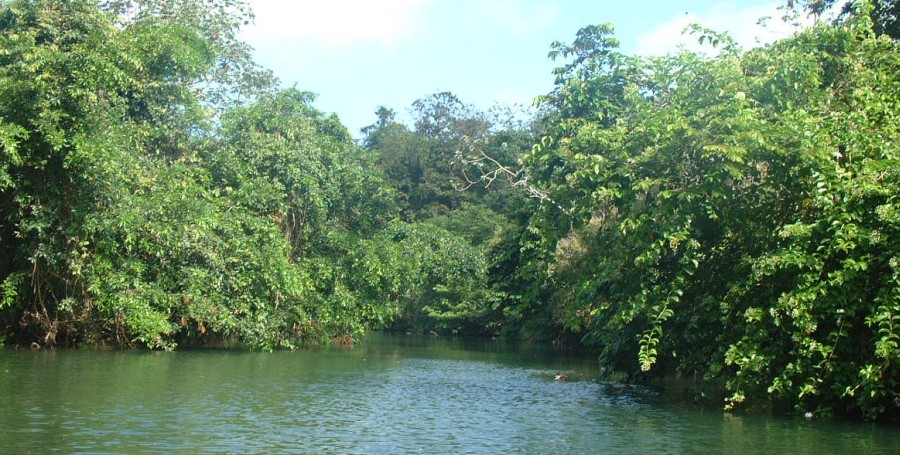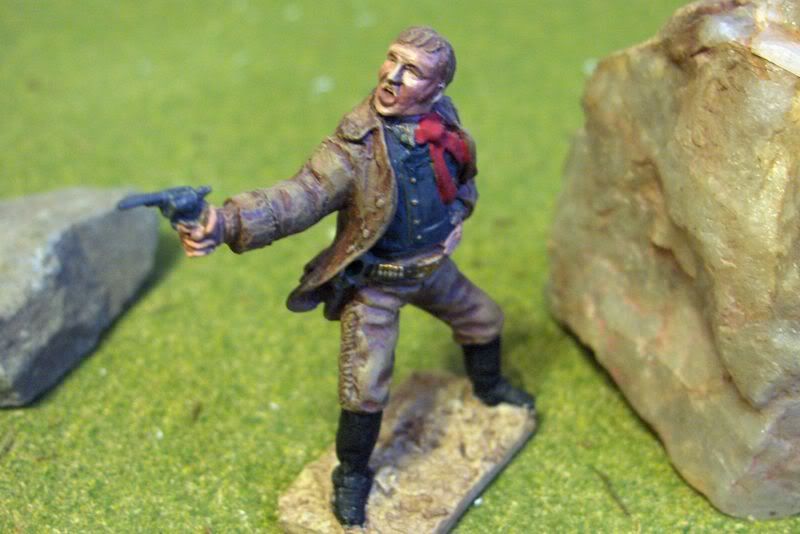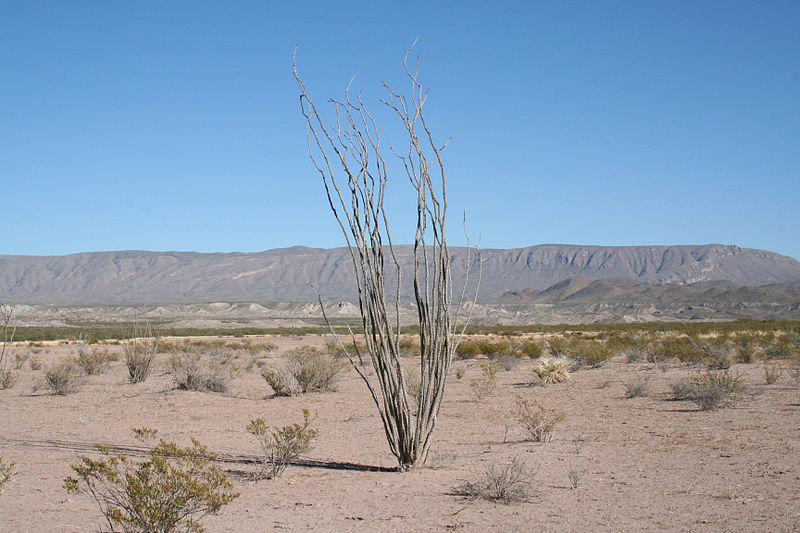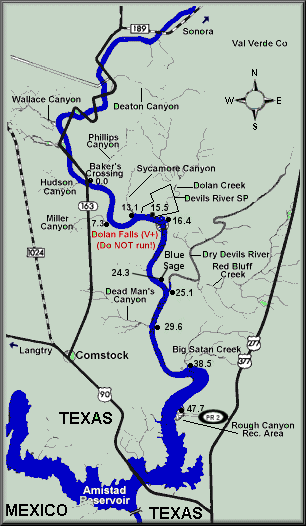 Near here once stood Camp Hudson, established by the U.S. Army in June, 1857 to protect the San Antonio-El Paso Road against hostile Indians. Hudson, also called Fort Hudson, was located on
Near here once stood Camp Hudson, established by the U.S. Army in June, 1857 to protect the San Antonio-El Paso Road against hostile Indians. Hudson, also called Fort Hudson, was located on San Pedro Creek, a tributary of the Devils River
San Pedro Creek, a tributary of the Devils River , twenty-one miles north of Comstock in central Val Verde County.
, twenty-one miles north of Comstock in central Val Verde County.

When a stagecoach was ambushed by Indians between Camp Hudson and Fort Stockton, and two military escorts were killed in late October, 1867, soldiers were once again sent to occupy the post.
 mannie gentile
mannie gentileOver the next several years, various companies occupied the post, which was re-organized in 1871. The soldiers were tasked with protecting travelers, new arrived settlers, and fought with Indians on several occasions.
By January, 1877, the threat of Indian attacks was over and the post was abandoned. The site is located in a desolate rock-strewn field. A state marker and a small gravestone are all that’s left of the old post. The site is located in Val Verde County, on Texas Highway 163, about 20 miles north of Comstock.
The camp was one of several posts built between San Antonio and El Paso to protect travelers on the so-called Chihuahua Trail. A local post office was opened in 1857.

The post was built along an elevated but isolated section of the creek, and few travelers or settlers came by in the early years.

Zenas R. Bliss, who was stationed at Camp Hudson for two years, reported seeing only four or five people during that time who were not related to the army.
 He was a United States army officer, born in Rhode Island and was appointed from his native state to the United States Military Academy at West Point on July 1, 1850. He graduated forty-first in his class and was assigned to duty as a brevet second lieutenant in the First Infantry on July 1, 1854.
He was a United States army officer, born in Rhode Island and was appointed from his native state to the United States Military Academy at West Point on July 1, 1850. He graduated forty-first in his class and was assigned to duty as a brevet second lieutenant in the First Infantry on July 1, 1854.
He was posted to Texas and served at Fort Duncan until 1855, when he was promoted to second lieutenant and transferred to an Eighth Infantry assignment at Fort Davis. In 1858 he served briefly at Camp Hudson and forts Inge and Mason and in 1859 at forts Mason and Clark.

Back at Camp Hudson he was promoted to first lieutenant in 1860 and to captain in 1861. Secession found Bliss at Fort Quitman. After Gen. David E. Twiggs surrendered the federal forts in Texas, Bliss attempted to march his garrison to the Texas Gulf Coast, but was intercepted by Confederate troops under Gen. Earl Van Dorn just west of San Antonio and held prisoner until April 5, 1862.
 images from the great quantrill blog
images from the great quantrill blogIn May 1862 he was commissioned as colonel of the Tenth Rhode Island Infantry, and in August he was transferred to the Seventh Rhode Island Infantry. Bliss was brevetted to major in the regular army in 1862 for "gallant and meritorious service" at the battle of Fredericksburg, Virginia, and to lieutenant colonel in 1864 for his service at the battle of the Wilderness.

At the battle of Fredericksburg Bliss led his regiment, which had never before been under fire, to within a few yards of the Confederate lines before being repulsed, thereby winning the Medal of Honor. With the end of the Civil War he was mustered out of volunteer service on (upnaway)June 9, 1865.

In the postbellum army Bliss was assigned as major of the Thirty-ninth Infantry on August 6, 1867, and transferred to the all black Twenty-fifth United States Infantry on March 15, 1869. Subsequently appointed commander of the Department of Texas, Bliss made his headquarters at San Antonio and served at forts Bliss, Clark, Davis, and Duncan between 1871 and 1879.

He was appointed lieutenant colonel of the Nineteenth Infantry in 1879 and promoted to colonel of the Twenty-fourth Infantryqv in 1886. He was promoted to brigadier general in 1895 and to major general in 1897 below the great aussie gunner upnaway, top bloke.

. He retired from active duty on May 22, 1897, and died in Washington, D.C., on January 2, 1900. A copy of his unpublished memoirs, Reminiscences of Zenas R. Bliss, is housed in the Barker Texas History Center at the University of Texas at Austin The walls of the buildings at Camp Hudson were constructed of a mixture of gravel and lime.

The process was slow, but it made the buildings cool in summer and warm in winter. In 1859 one of the experimental camel caravans of camels from Camp Verde passed through Camp Hudson. The troops left on March 17, 1861, for service in the Civil War. In 1866 the post office closed(above new Andrea , a metal model but food for thought as regards plastic conversion).
 In late October 1867 a stage from Camp Hudson to Fort Stockton was ambushed by Indians, and two military escorts were killed. In November, immediately after the stage attack, companies D and G of the Ninth Cavalry were ordered to Camp Hudson. By April 1868 other troops had returned to the area.
In late October 1867 a stage from Camp Hudson to Fort Stockton was ambushed by Indians, and two military escorts were killed. In November, immediately after the stage attack, companies D and G of the Ninth Cavalry were ordered to Camp Hudson. By April 1868 other troops had returned to the area. In April 1871 Camp Hudson was reorganized with three commissioned officers and sixty enlisted men. In March 1876 Lt. Col. George Pearson Buell came to Camp Hudson from Fort Concho with two companies of cavalry. Under his leadership, the post was to be used as a summer camp to protect newly arrived settlers. The troops at Camp Hudson fought with Indians on several occasions and sometimes followed them into Mexico. In April 1876 Lt. Louis Henry Orleman was sent to Camp Hudson to take command of Company B of the Tenth Cavalry. In January 1877, however, Camp Hudson was permanently closed because the threat of Indian attacks no longer existed. In 1936 The Texas Historical Commissionqv placed a centennial marker at the site of Camp Hudson. By the 1980s no buildings stood on the private property where the camp was once situated.
In April 1871 Camp Hudson was reorganized with three commissioned officers and sixty enlisted men. In March 1876 Lt. Col. George Pearson Buell came to Camp Hudson from Fort Concho with two companies of cavalry. Under his leadership, the post was to be used as a summer camp to protect newly arrived settlers. The troops at Camp Hudson fought with Indians on several occasions and sometimes followed them into Mexico. In April 1876 Lt. Louis Henry Orleman was sent to Camp Hudson to take command of Company B of the Tenth Cavalry. In January 1877, however, Camp Hudson was permanently closed because the threat of Indian attacks no longer existed. In 1936 The Texas Historical Commissionqv placed a centennial marker at the site of Camp Hudson. By the 1980s no buildings stood on the private property where the camp was once situated. The post was evacuated during the Civil War, but, re-occupied afterwards. It was abandoned again in April, 1868. Unfortunately, there are no remains today. This area, also called Baker's Crossing is a popular entry point for rafters along the river.
The post was evacuated during the Civil War, but, re-occupied afterwards. It was abandoned again in April, 1868. Unfortunately, there are no remains today. This area, also called Baker's Crossing is a popular entry point for rafters along the river. 
A great, lost Hill Country river, a spring-fed jewel on the western edge of the Edwards Plateau, running swift and fast through that vague badlands where Tamaulipan scrub -- also known as South Texas brush country -- fades into the Chihuahuan Desert,
 from somewhere between Ozona and Sonora down to just above Del Rio, where it dissolves into Lake Amistad.
from somewhere between Ozona and Sonora down to just above Del Rio, where it dissolves into Lake Amistad.
Its almost-Caribbean hue is striking, as pretty pale as a summer sky. The water brimming with smallmouth bass you could follow with your eyes, the clarity was so sharp.

The Devils lives up to its name. It is almost impossible to see, landlocked by sprawling ranches whose owners have been known to vigorously file trespassing charges and sometimes take even more extreme measures to discourage river use by outsiders.

It is wild, empty country. Spotting wild turkeys is easier than spotting another human.
The first European to note the Devils' existence, the Spaniard Gaspar Casta–o de Sosa, was not exactly impressed. He named it the Laxas, which translates as "feeble" or "slack." Explorers and travelers who followed him held it in higher regard, naming it the San Pedro, and often lingering longer than planned, since it was the last rest stop before striking out west across the desert.
St. Pedro struck Texas Ranger Jack Hays as an uninspired name for the river when he came upon it in the 1840s, before he moved on to California.  He reckoned the Devils would be a more suitable title. A military camp had been established on the river after the Mexican War. Another Texas Ranger, Capt. Pat Dolan, arrived to clear the region of outlaws in 1870, early enough to have his name attached to the falls.
He reckoned the Devils would be a more suitable title. A military camp had been established on the river after the Mexican War. Another Texas Ranger, Capt. Pat Dolan, arrived to clear the region of outlaws in 1870, early enough to have his name attached to the falls.
 He reckoned the Devils would be a more suitable title. A military camp had been established on the river after the Mexican War. Another Texas Ranger, Capt. Pat Dolan, arrived to clear the region of outlaws in 1870, early enough to have his name attached to the falls.
He reckoned the Devils would be a more suitable title. A military camp had been established on the river after the Mexican War. Another Texas Ranger, Capt. Pat Dolan, arrived to clear the region of outlaws in 1870, early enough to have his name attached to the falls.
That made it safe for E.K. Fawcett who, along with a group of friends, left his mark inside a cave above Dolan Falls on July 24, 1883. As the Devils' first settler, Fawcett started grazing sheep by the falls, and others followed with goats and cattle. Eventually the grasses in the watershed were worn down to the nub, leaving rocks, prickly pear, cedar, mesquite and the occasional lechuguilla.
 owsing down explained why I heard but a single calf on the trip. Not much is left for today's livestock to eat
owsing down explained why I heard but a single calf on the trip. Not much is left for today's livestock to eat
 owsing down explained why I heard but a single calf on the trip. Not much is left for today's livestock to eat
owsing down explained why I heard but a single calf on the trip. Not much is left for today's livestock to eat

 tounding metaphors from the most unusual subjects.
tounding metaphors from the most unusual subjects. 



